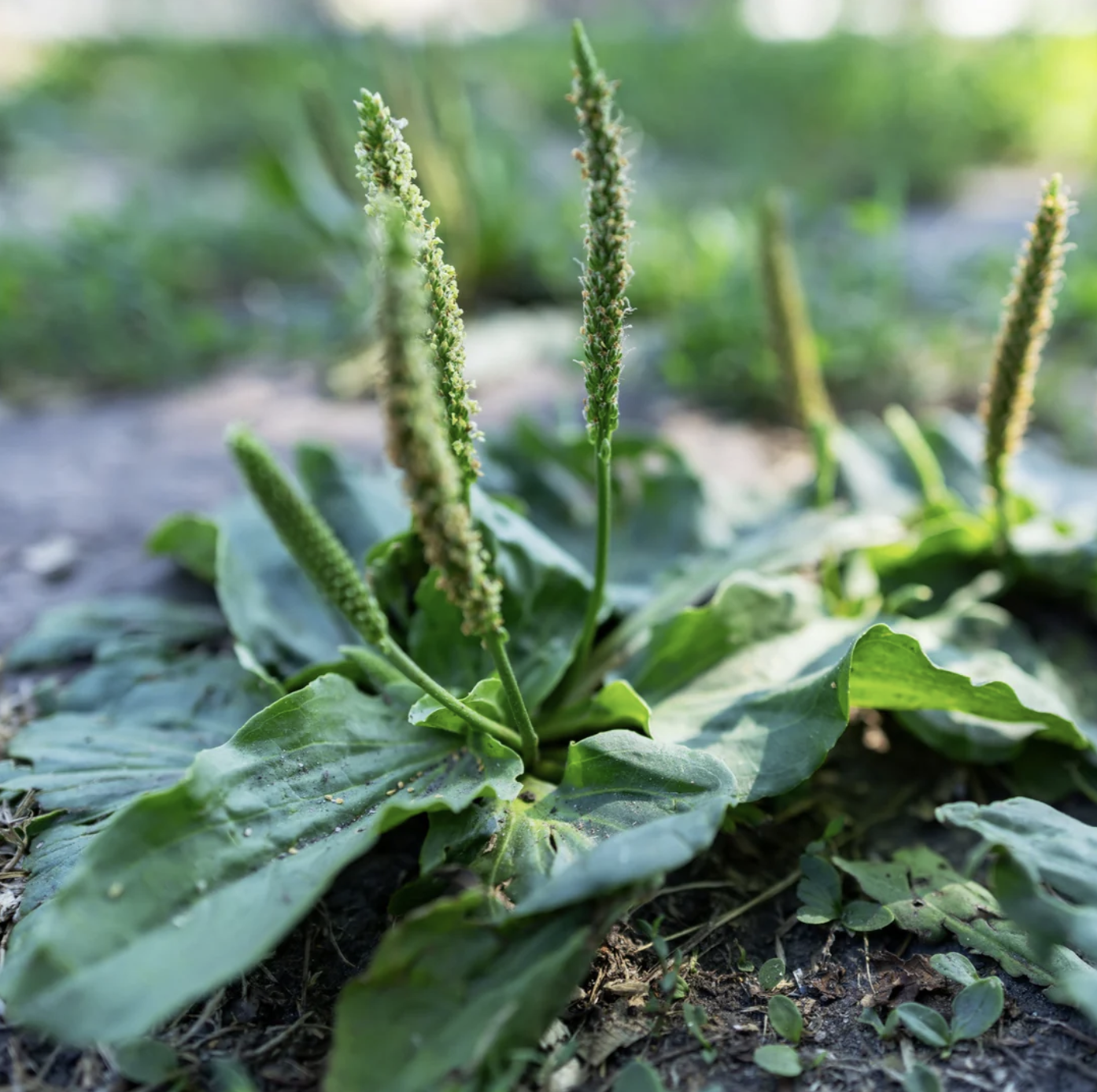Plantain: The Wild Healer Beneath Your Feet
I still remember the first time I truly saw plantain. I had passed her hundreds of times—trampled along trails, poking through sidewalk cracks, quietly thriving in forgotten corners of the garden. But my good friend and herbalist, Shontel Sutton Heim introduced me to this miracle plant. I traced the veins on her broad, low-growing leaves, noted the strength in her soft resilience, and knew: this was a plant with purpose.
In the world of herbalism, plantain (not to be confused with the banana-like fruit) is a gentle powerhouse—humble, abundant, and deeply healing. She’s the kind of ally who meets you where you are, offering her medicine freely and generously.
Once you get to know plantain you will notice her right in all of the right places. By basketball courts for skinned knees, around the playgrounds, and steps away from stinging nettle. She is always where you need her.
What Is Plantain?
There are two common species: Plantago major (broadleaf plantain) and Plantago lanceolata (narrowleaf or ribwort plantain). Both grow wild across North America, Europe, and beyond, thriving in compacted soil and disturbed spaces—testament to their grounding, adaptable energy.
You’ll know plantain by her:
Distinct leaf ribs (which run parallel from base to tip)
Low-growing rosette form
Tiny green-brown flower stalks that shoot up like wands
To me, she feels like Earth’s bandaid. And once you get to know her, you’ll start spotting her everywhere.
The Herbal Uses of Plantain
Plantain is rich in mucilage, tannins, and allantoin, all constituents that make her cooling, moistening, and wonderfully anti-inflammatory. Here’s how I use her at home and in the wild:
1. Bug Bites, Cuts & Stings
Plantain is my go-to for anything itchy, inflamed, or irritated. Crushed fresh into a spit poultice (yes, literally chew and place it on the skin), she pulls toxins out, soothes the site, and helps speed healing. My kids have know to run for plaintain after any run in with stinging nettle, or after a bug bite, or even a nasty run in with barnacles.
2. Stop the Bleed: Plaintain for Wounds
One of the lesser-known (but incredibly powerful) uses of plantain is its ability to stop bleeding and support wound healing.
If you or your little ones get a scrape, cut, or even a minor gash while outside, plantain can be your first aid hero. Simply crush a fresh plantain leaf (chewing works in a pinch) and press it directly onto the bleeding area. Its astringent properties help constrict blood vessels, slow or stop the bleeding, and promote clotting—often within minutes.
You can hold the crushed leaf in place with a clean cloth or bandage, or make a quick poultice. It’s especially helpful when you’re out hiking or at the park and need immediate, natural support.
3. Digestive Support
Thanks to her demulcent nature, plantain tea or infusion can gently coat and calm the gut. I turn to her when there’s inflammation, ulcers, or even just too much heat in the belly. She pairs well with calendula or marshmallow for deeper gut repair.
4. Respiratory Relief
Plantago lanceolata, in particular, shines for the lungs. She soothes dry, scratchy coughs and supports expectoration. I often make a simple syrup with her leaves and a bit of maple syrup to keep on hand for wintertime coughs.
5. Drawing Out Splinters & Infection
Plantain has an affinity for drawing: splinters, boils, even minor infections. Apply her as a poultice or in salve form and watch her gentle magic work. She’s grounding medicine, working slowly but surely.
Foraging & Harvest Tips
Plantain is safe and easy to identify, making her a perfect plant for beginner foragers. Here are a few gentle guidelines:
Harvest away from roadsides or sprayed lawns. Look for healthy, vibrant leaves in untreated areas.
Pinch, don’t pull. Leave the root intact to allow continued growth.
Dry on a screen in a warm, shady place if you’re making teas or salves later.
Always ask permission…from the land, and from the plant herself. A simple breath, a thank you, a pause—this is how we begin to heal our relationship with the earth.
How I Work With Her in the Apothecary
In my home apothecary, you’ll always find:
A plantain salve with calendula (Shontel makes an AMAZING magic salve: we keep one at home and one in the car!)
Dried plantain leaf for infusions
You might add:
A small jar of honey infused with P. lanceolata for coughs
Plantain is a foundational plant in my children’s herbal toolkit and a sacred reminder that some of the most powerful medicine doesn’t come in glass bottles-it grows at our feet.
In Closing
Plantain reminds us to look closer. To bend down. To reconnect with what’s already here.
She teaches that healing doesn’t have to be complicated. It can be simple. Unassuming. Soft. Steady. She teaches that we too are resilient, even after being stepped on.
So next time you see her growing wild and wide, offer a nod. She just might have something for you.
With grounded love,
Danielle 🌿


